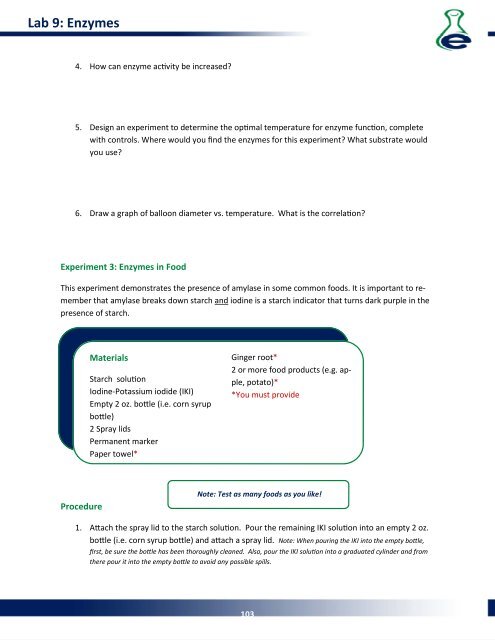Lab Manual - eScience Labs
Lab Manual - eScience Labs
Lab Manual - eScience Labs
Create successful ePaper yourself
Turn your PDF publications into a flip-book with our unique Google optimized e-Paper software.
<strong>Lab</strong> 9: Enzymes<br />
4. How can enzyme acvity be increased?<br />
5. Design an experiment to determine the opmal temperature for enzyme funcon, complete<br />
with controls. Where would you find the enzymes for this experiment? What substrate would<br />
you use?<br />
6. Draw a graph of balloon diameter vs. temperature. What is the correlaon?<br />
Experiment 3: Enzymes in Food<br />
This experiment demonstrates the presence of amylase in some common foods. It is important to remember<br />
that amylase breaks down starch and iodine is a starch indicator that turns dark purple in the<br />
presence of starch.<br />
Materials<br />
Starch soluon<br />
Iodine-Potassium iodide (IKI)<br />
Empty 2 oz. bole (i.e. corn syrup<br />
bole)<br />
2 Spray lids<br />
Permanent marker<br />
Paper towel*<br />
Ginger root*<br />
2 or more food products (e.g. apple,<br />
potato)*<br />
*You must provide<br />
Procedure<br />
Note: Test as many foods as you like!<br />
1. Aach the spray lid to the starch soluon. Pour the remaining IKI soluon into an empty 2 oz.<br />
bole (i.e. corn syrup bole) and aach a spray lid. Note: When pouring the IKI into the empty bole,<br />
first, be sure the bole has been thoroughly cleaned. Also, pour the IKI soluon into a graduated cylinder and from<br />
there pour it into the empty bole to avoid any possible spills.<br />
103
















